
Aloe is a genus containing over 650 species of flowering succulent plants. The most widely known species is Aloe vera, or "true aloe". It is called this because it is cultivated as the standard source for assorted pharmaceutical purposes. Other species, such as Aloe ferox, are also cultivated or harvested from the wild for similar applications.
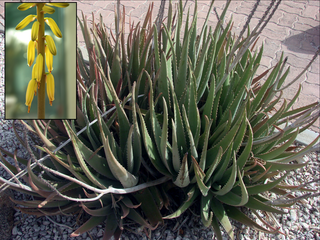
Aloe vera is a succulent plant species of the genus Aloe. It is widely distributed, and is considered an invasive species in many world regions.
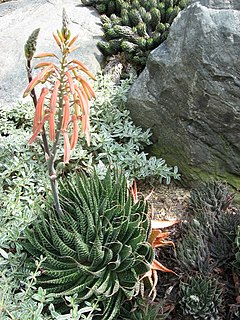
Aristaloe is a genus of evergreen flowering perennial plants in the family Asphodelaceae from Southern Africa. Its sole species is Aristaloe aristata, known as guinea-fowl aloe or lace aloe.
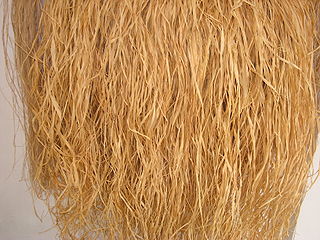
Raphia vinifera, the West African piassava palm, bamboo palm or West African bass fibre is a palm tree species in the genus Raphia. It is native to Benin, Gambia, Ghana, Nigeria, Togo, Central African Republic, Cameroon, Ghana, and Democratic Republic of the Congo. It is particularly abundant along the creeks of Niger Delta, Cross River, Lagos and Ikorodu in Nigeria.

Monodora myristica, the calabash nutmeg, is a tropical tree of the family Annonaceae or custard apple family of flowering plants. It is native to Angola, Benin, Cameroon, the Central African Republic, the Democratic Republic of the Congo, Equatorial Guinea, Gabon, Ghana, Guinea-Bissau, Ivory Coast, Kenya, Liberia, Nigeria, the Republic of the Congo, Sierra Leone, Sudan, Tanzania, Togo and Uganda. In former times, its seeds were widely sold as an inexpensive nutmeg substitute. This is now less common outside its region of production. Other names of calabash nutmeg include Jamaican nutmeg, African nutmeg, ehuru, ariwo, awerewa, ehiri, airama, African orchid nutmeg, muscadier de Calabash and lubushi.

Aloe comosa is a species of flowering plant in the Asphodelaceae family. It is commonly called Clanwilliam aloe) and is endemic to South Africa.
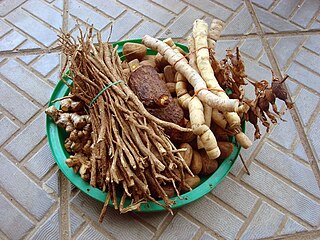
Corynanthe johimbe, common name yohimbe, is a plant species in the family Rubiaceae native to western and central Africa. Extracts from yohimbe have been used in traditional medicine in West Africa as an aphrodisiac and have been marketed in developed countries as dietary supplements.

Margaritaria discoidea is a tree in the family Phyllanthaceae, commonly known as the pheasant-berry, egossa red pear or bushveld peacock-berry. These trees are native to the warmer, higher rainfall areas of Africa.

Kumara plicatilis, formerly Aloe plicatilis, the fan-aloe, is a succulent plant endemic to a few mountains in the Fynbos ecoregion, of the Western Cape in South Africa. The plant has an unusual and striking fan-like arrangement of its leaves. It may grow as a large multistemmed shrub or as a small tree. It is one of the two species in the genus Kumara.

Aloiampelos commixta is a flowering plant in the Asphodelaceae family. It is commonly called Table Mountain aloe, and is a rare succulent plant that is endemic to the Cape Peninsula, South Africa. It naturally occurs only on the Table Mountain range, within the city of Cape Town.
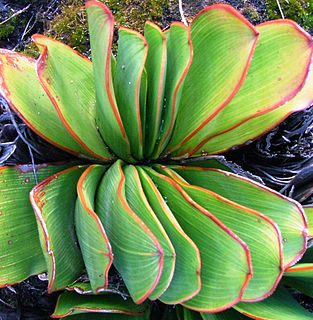
Kumara haemanthifolia is a species of flowering plant in the family Asphodelaceae. It is a rare species of succulent plant, native to a few high, inaccessible mountain peaks in the Fynbos habitat of Western Cape, South Africa.

Aloe littoralis is a flowering plant in the Asphodelaceae family. It is a succulent native to arid regions in South Tropical Africa and Southern Africa.

Aloe lomatophylloides is a unique species of Aloe endemic to the island of Rodrigues, in the Indian Ocean. It is part of a group of aloes which bear fleshy berries, and were therefore classed as a separate group, Aloe section Lomatophyllum.

Ficus exasperata, also called the sandpaper tree, forest sandpaper fig, white fig, or sandpaper leaf tree, is a deciduous, and dioecious species of plant in the mulberry family Moraceae, native to tropical Africa and southern Asia.
Aloe pembana is a species of Aloe indigenous to the island of Pemba and surrounding islets, off the coast of Tanzania.

Aloe aldabrensis is a species of Aloe endemic to the islands of Aldabra in the Indian Ocean, where it can still be found in coastal scrub on limestone-based soil.
Aloe mayottensis is a species of Aloe indigenous to the island of Mayotte and surrounding islands of the Comoros, in the Indian Ocean. Formerly more widespread, it is now rarely found outside of cultivation.

Aloe globuligemma, commonly known as the witchdoctor's aloe, is a species of flowering plant in the family Asphodelaceae. It is native to southern Africa where it occurs in semi-desert and dry bushland. It is an evergreen, succulent, perennial plant. The plant forms large, dense clumps. It is harvested from the wild for local medicinal use.

Aloeae is a tribe of succulent plants in the subfamily Asphodeloideae of the family Asphodelaceae, consisting of the aloes and their close relatives. The taxon may also be treated as the subfamily Alooideae by those botanists who retain the narrower circumscription of Asphodelaceae adopted prior to the APG III system. Typically, plants have rosettes of more or less succulent leaves, with or without a distinct stem. Their flowers are arranged in racemes and tend to be either small and pale, pollinated by insects, or larger and more brightly coloured, pollinated by birds. As of 2017, 11 genera are recognized, most created since 2010 by splitting off another five genera from Aloe and another two from Haworthia. Only two genera, Aloe and Aloidendron, are native outside southern Africa, extending northwards to the Arabian Peninsula. Seven genera are restricted to South Africa, some with small ranges. Members of the Aloeae are cultivated by succulent plant enthusiasts; Aloe species especially are used in temperate climates as ornamental garden plants. Some species are used in traditional medicine. Aloe vera and Aloe ferox are cultivated for their extracts, whose uses include moisturizers and emollients in cosmetics.
Tapinanthus bangwensis is a species of hemiparasitic plant in the family Loranthaceae, which is native to the tropics of western sub-Saharan Africa.

















